![]()
RED JOS
MANNIE DE SAXE GENEALOGY
CHAPTER 4
KUPER FAMILY
Indexed by the FreeFind Search Engine

CHAPTER 1: MENDELSSOHN FAMILY PART 1
CHAPTER 2: MENDELSSOHN FAMILY PART 2
CHAPTER 6: THE STORY OF MORRIS (DE SAXE)

Many people have contributed to the information on this page, helping to
build up this Kuper family history, and I will try
and list them all. If I have left any person or people out,
it is inadvertent and I hope they will advise me accordingly. Thank you:
Cecily Freed
Elaine Katz
Ruth Kuper
IN FOND MEMORY OF OUR COUSIN DR.
CECILY FREED WHO DIED ON 12 APRIL 2009
AGED 88. SURVIVED BY HER NEPHEW BRIAN BUCH AND NIECE MARGARET
BUCH.
This is the Kuper Genealogy.ppt - a Powerpoint Presentation built by Cecily, Elaine and Ruth

Indexed by the FreeFind Search Engine

KUPER GENEALOGY
The Kuper family tree is a bit more complicated than some of the others because we are missing so many dates that it is difficult to determine accurately some of the details.
The following was drawn up by three of my Kuper cousins, finalized by them on13 February 2004, and starts with their introduction:
"We, Cecily Freed, Elaine Katz and Ruth Kuper, have attempted to reconstruct the Cooper/Kooper/Kuper family tree.
Here it is.
While there are errors and omissions it is nevertheless reasonably
comprehensive. With a compass to guide you, you should be able to navigate it
with comparative ease.
We believe the
progenitor of us all to have been called
As to dating. The
clue comes from the interview between
There is a
complicating factor, however. Little Leo, second son of Moshe, grandson of Chaim, told Adam Kuper that Chaim had come to South Africa in the 1860s, returned to
Lithuania and finally emigrated in the 1880s (+/- 1885). If he had been born in
1850, he would have first come to
You choose.
We also have
an addendum to the interview between
The British
believed he was spying for the Boers, but he always denied it and no one knew
where the truth lay. Adam says the people sent to Port Alfred were the ongewensdes: undesirable but not sufficiently dangerous to
be sent out of the country.
You decide.
So here it is.
We hope you will find it of interest.
All the best to all of you."
----------------------------------------------------------
--------------------------------------------------------------------------------------------
INTERVIEW WITH ISRAEL KUPER
By Dora Sowden. 1953
ORIGINS
Israel Kuper, son of Chaim Kuper, was born in Yanova, Lithuania, on 13 JUNE 1883. His father went to South Africa when Israel Kuper was 18 months old because it was almost impossible to make a living in Russia. His father first went to Oudtshoorn, where he stayed for 3 or 4 years. In 1888 he came to Johannesburg.
SOUTH AFRICA
In 1893 Israel Kuper came to South Africa with his mother (and a brother. His brother, Morris, was 8 years his senior.)
They stayed for a couple of days in Franks Boarding House in Cape Town because it was Rosh Hashona, and then they came up to Johannesburg.
JOHANNESBURG
His father, Chaim (Charles) Cooper or Kooper or Kuper, was a shoched for Morkel, the only Kosher butcher then in Johannesburg (he also sold treifa meat). He got 30 shillings a month. They lived in a semi-detached house in Bezuidenhout Street, Ferreira, for which they paid 5 shillings per month (it belonged to his uncle Simcha). He remembers that they were not short of anything and life was much better than in Yanova.
Israel continued his Talmudical studies at the Beth Hamedrash in Fox Street, to the exclusion of everything else. He spoke only Yiddish for the next 6 years. The Shammas and Bal Tefillah was Michalisky, who was also his rebbe.
There was then no dayan or rabbi.
His fathers brothers were Joshua (Moshe), Simcha, Jacob, Meyer and Abraham. His uncle Simcha had a Kosher boarding house, also a public house at the corner of Bezuidenhout Street.
In 1895 his uncle Abraham took him for a holiday near Port Elizabeth. He remembers there were soldiers in Marshall Square. A number of people left Johannesburg. He came back to Johannesburg in 1896 after the Jameson Raid. He studied with Reb. Shapshe Resnik for the 3 months until his Barmitzvah.
At his Barmitzvah, he remembers there were many lamdonim present. He himself gave a pilpul on the Gmorro. Of the learned Jews of the time he remembers: Peretz Rosenberg, Mottle Milevitsky, Chaim Peretz Goodman, Elia Zaks, Elia Aaron Hirshowitz, Edelzak, Chatzkel Rabinowitz, Mottle Cohen, Eliahu Aaronsohn, Reb. Shapshe Resnik, his own father and Velve Michalisky. His Barmitzvah took place in 1896. That year the shul was enlarged. In 1897 Dagutsky came to Johannesburg and caused a feud in the orthodox congregation. Simcha and Chaim Kuper took opposite sides. The committee resigned.
The breach was so serious that the brothers, Simcha and Chaim, did not speak to each other. The committee resigned just before Shevuoth and there was no one to distribute aliyahs. Jekele (Jacob) Hoffman took it upon himself to distribute the aliyahs on the first day. On the second day, Motte Goldberg, a carpenter, but a macher in the community, went up to the Omed and, banging it with his fist, said, Brider, as mir vellen alle in ardes vet zain colon Chachomim, anit is in drerd brider, in drerd. Coleine ivanim, and he stamped on the Omed.
SECULAR SCHOOLING, ETC.
Until his Barmitzvah he did not talk English, and for the first 6 years or so of his stay in South Africa, he studied only Talmud. It was possible to live a completely isolated Jewish life in those days, within the Jewish community.
In 1898, a bookkeeper named Myerson a maskil pointed out to his father that he would be greatly handicapped if he were not sent to school. His father gave the matter some thought and eventually agreed. Myerson was a man who knew German, French, Latin, Greek, Dutch and English, as well as Hebrew. For 4 months he taught Israel Kuper, who was then admitted to the sixth standard at the Marist Brothers. At that time, 1898, Reb Maishel Friedman was his rebbe. In June 1899 he took and passed his elementary School Examination and started going to High School.
In 1899 when war threatened he went down to his uncle Myers place, a farm at Klipdrift, 14 miles from Oudtshoorn. His father was then engaged in cattle dealing. Israel Kuper remained in the Cape Province from September 1899 to the end of 1901. He matriculated at Outdshoorn Boys High School. In April 1902, he went to S.A.C.S to study law. He remained until September 1902. In 1902 he came back on holiday to Johannesburg, and as he was not happy with the attorney with whom he had been articled in Cape Town, (Charles Friedlander), he decided to break his articles and remain in Johannesburg. He became articled to S. Zwarenstein and attended the law classes of I. Hayman. He qualified in December 1905, and began practice in 1906 in partnership with B. Zwarenstein, with whom he remained only for one year. In 1907-8 he was in partnership with M. Kaplan.
He had met Cecilia Gordon in 1904, shortly after she came to this country and they were married in December 1906.
In 1908 he moved to Benoni, where he went into practice on his own. Benoni was then only a mining camp. The shul had just been built. He took an active part in Jewish communal matters and became the President of the congregation. He was not the first President (Benjamin Bloch may have been the first President).
In 1911 he fought a municipal election and became a town councillor in Benoni. He then joined the Labour Party and became very active in the movement. He was made an Honorary Member of the Transvaal Miners Association (there were very few such honorary members) and in that capacity attended a meeting held at the Constitutional Hall in Benoni. Of the 40 persons present, the only one who did not have phthisis was Israel Kuper and this made such an impression on him that he threw himself heart and soul into work for them and neglected his business and everything else. In 1913 a strike was declared by the mine workers in Benoni (May or June) and it spread to other parts of the Rand. Naturally he took the part of the workers and as a practising attorney (the firm was then Kuper, Foley and Reid) he appeared for all the strikers who were arrested, bailed out most of the leaders, including Waterson (Waterston), Tom Matthews, J.T.Baines, George Mason, etc., and generally gave the police a rough time.
That strike finished in July 1913. In December 1913 a general strike was declared by the workers on the Rand, including the railwaymen. The night before the strike was declared, a public meeting of two or three thousand people took place out in the open. Israel Kuper presided and strongly advised them to consider carefully before declaring a strike. He suspected that the strike was actually being induced by the government at the time to break the Trade Union Movement. However, the decision to strike was taken and at midnight the strike was declared. Immediately Martial Law was also declared and a day later Israel Kuper was arrested and put in jail at the Benoni Police Station (about 200 others were also arrested). On the Saturday the police decided to move him to Boksburg. He thinks that the police intentionally made the removal on Saturday because Colonel Kirkpatrick, the Inspector of Police on the East Rand, wanted to have his own back against him. He knew he was an observant Jew and that it was against his wish to travel on the Sabbath, but he was angry because he had shown such friendship to the strikers in the earlier strike. Though Israel Kuper offered to pay for transport on Saturday after the Sabbath was over or even walk to Boksburg, he was not permitted to do this and was made to go in a black Maria.
He was kept in Boksburg for 14 days. At the time he was Chairman of the Finance Committee of Benoni Town Council and cheques had to be sent to him in prison to be signed. This was in January 1914. His wife sent him a mattress and silk pyjamas and another of those who were arrested, Dan Simon, said he wanted to write a book about Israel Kuper in jail with silk pyjamas and a lovely mattress.
On the Saturday, a fortnight after he was sent to Boksburg, he was brought before the Magistrate, Sam Elman. They could not make a charge against him and he had been kept in prison without being charged. (Creswell was then charged). The others were let out on bail. When he was called up the Magistrate told him that he would let him out on 50 shillings bail but he had to sign the bail bond. As it was the Sabbath, Israel Kuper refused to write. The magistrate threatened to send him back to jail but he said he was willing to remain he liked it and refused to sign. Afterwards, the Magistrate changed his mind and let him go. His wife and friends and relations had walked from Benoni to walk back with him and at Dunswart a reception committee was waiting. They walked back to his home.
In March of that year (1914) he fought a Provincial Council election. He stood against B. Owen Jones, who had been an M.P. for the Transvaal before Union and the first Provincial Councillor after Union. Israel Kuper was elected with a 2 to 1 majority. He remained an M.P.C. for 9 years, being elected three times in succession. He was Mayor of Benoni in 1917-1918.
When the war broke out he served in the forces.
REMINISCENCES
He remembers as a child he was put up on the Bima by his uncle Simcha because he was so good at his religious studies. When asked to deven, he said, Dafke niet.
When he wrote his School Higher Examination (the year before he matriculated), there were only 6 candidates: 2 boys and 4 girls. He was the only Jew. For some reason he did a bad Arithmetic Paper and only towards the end doing his last two sums he recovered. The invigilator was a Rev. Rousseau and when he looked at his paper and saw that he was the only one who had got the last sums stocks and shares right, he said, Die Jode is met geld gebore.
While his father and the Simcha Kuper family were in enmity because of Dagutsky, Chaia Kuper, Simchas wife, came into their house on Yom Kippur just before Kol Nidrei and cursed the whole family. Needless to say, her curses had no effect, but it was astonishing that a woman who was so frum should allow herself such behaviour.
A SPECIAL INCIDENT
Chaim Kuper, Israels father, was a Mohel but performed the service gratis sometimes even for non-Jews. He would on occasion go as far as the Orange Free State to perform the ceremony and paid his own expenses. One day he attended a Brith in Braamfontein. The father of the child was running a butchery and kept open on the Sabbath. It was practically a rule with Chaim Kuper not to eat at these places, in order to avoid the problem of what was Kosher, but on this occasion the people persisted. When Chaim Kuper continued to refuse, they pressed him for an answer. Chaim Kuper, irritated by them, said he did not consider food Kosher which was sold in a shop that kept open on the Sabbath. On the Monday following, Chaim Kuper received a letter of demand for 100 shillings and a summons was issued. He came up before a magistrate called Jordaan, and after a contest the magistrate awarded 5 shillings damages and costs to the butcher. After the judgment Israel Kuper went into the office of the Magistrate and said, I bet you 1 shilling that the judgement will be reversed on appeal. The Magistrate took him on and the case went to appeal and Israel Kuper won his 1 shilling.
Once when Cecilia Kuper went canvassing for Israel Kuper during a municipal election campaign, she came to a house where there were 7 voters. Being shy to ask for the votes for her husband, she asked the woman of the house whether she would vote for the Labour Party (to which Israel Kuper belonged). No, said the woman, our votes go only to one man, Israel Kuper, because he was so good to us at the time of the strike.
The reason why his father (Chaim) and Simcha differed so strongly about Dagutsky (pre-war) was because his father did not think Dagutsky good enough to be the Rov of the orthodox congregation.
WORLD WAR 1
Because he was a public figure, it was incumbent upon him to join the forces. He became NCO and trained in the Transvaal, but was also sent to Kroonstad. Cecilia Kuper says that Col. Creswell, who was his commanding officer, complained that they had trouble about his diet. He would not eat non-Kosher food and therefore would not touch meat or such foods. He became a Lieutenant and was sent to South West Africa, where he remained for about 6 weeks. He did not take part in any fighting. Whether it was that his dietary observance did prove troublesome or not, he was given his discharge by Col. Creswell and returned to Benoni.
-------------------------------------------------------------------------------------------------
Cecily Freed
Elaine Katz
Ruth Kuper
13 February 2004
Here are the 8 children of Israel Kuper in the order in which they are presumed to have been born:
*Moshe (Joshua)
*Chaim
*Abraham
*Simcha
*Jacob
*Myer
*Leibe
*Chana Rochel

MAY 2012 UPDATE:
I FOUND DEREK WALKER'S DETAILS ONLINE WHEN I DISCOVERED
HE WAS INVOLVED WITH PHOTOGRAPHY OF HISTORICAL CEMETERIES, MONUMENTS AND OTHER
RELATED SITES IN AND AROUND

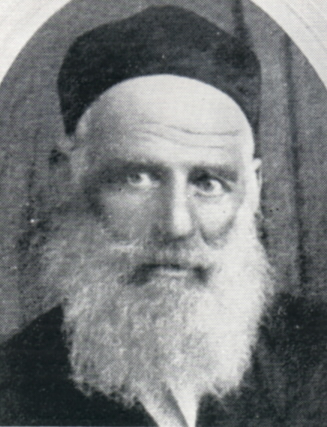
This is a photo of one of my Kuper
great-grandfathers, Chaim Kuper,
my grandfather Morris (Moshe) Kuper's father. The
photo was probably taken between 1890 and 1910 and, according to information
from Derek Walker, it seems Chaim was called Charles,
born 1854, died

My great-grandmother, wife of Chaim Kuper, and photo probably the same time as the one of Chaim above.
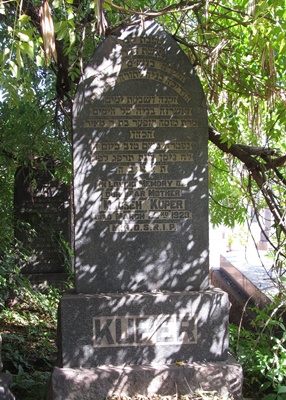
Photo by Derek Walker May 2012 who provided the following information: Mussa Kuper, born 1850, died
Derek also sent this approximate translation of the Hebrew on the tombstone:
MONUMENTAL
A WOMAN WHO WAS SOCIABLE/FRIENDLY (Guesswork the sun was shining on this spot
but that is what the sentence should read)
PRECIOUS TO PEOPLE AND HER FAMILY (Family is guess but it makes sense)
GUIDED HER SONS IN THE WAY OF THE TORAH AND SUNSHINE ? (the
last word is a problem but as you can see its not that important for
genealogy)
ELDERLY AND SATIATED OF DAYS.
SACRED TO HER SONS ALWAYS
(MRS) MOSA KUPER daughter of MEYER THE COHEN
DIED WITH A GOOD NAME
ON THE 5TH DAY OF NISAN IN THE YEAR 5683 (*This is the Hebrew date according to
the Good Book)
MAY HER SOUL BE BOUND IN THE BONDS OF EVERLASTING LIFE

Probably one of the brothers of Chaim Kuper, and possibly living in Oudtshoorn where this photo was taken.

Is this a photo of my other Kuper great-grandfather Simcha, Pessa's father, and the father of Tziporah and Luba, daughters from each of his three wives?

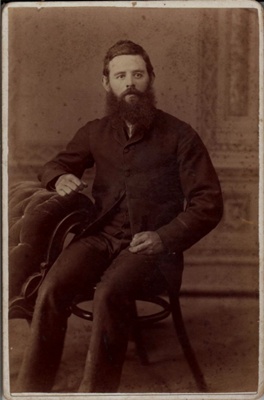


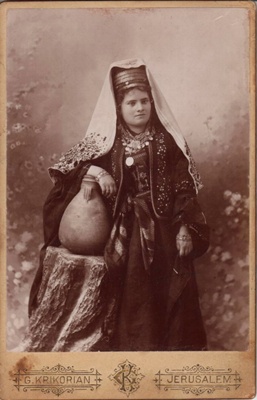
I do not know who most of the people in the above photos are, but believe
them to be most of the brothers of Chaim, one of my
great-grandfathers, and the woman in the bottom photo may well be their only
sister (Chana Rochel - Litvin?). However, the photo was taken in
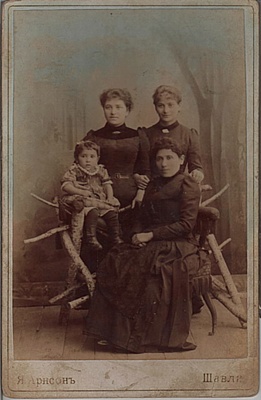
My grandmother Pessa, her sister Tziporah in the back row, Luba
and her mother in the front row, and the photo probably taken in Radvilishik in Lithuania, before any of them went to South
Africa - in the late 1880s? leaving Luba and her mother in
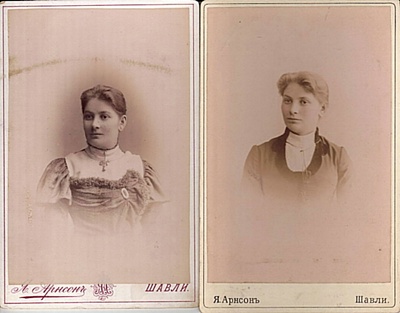

The above three photos of Tziporah were taken in
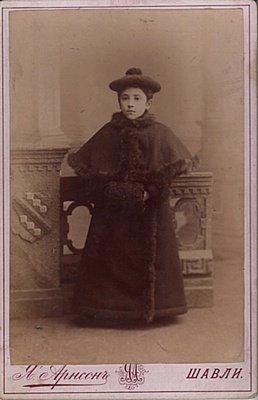
Luba aged about 10 in
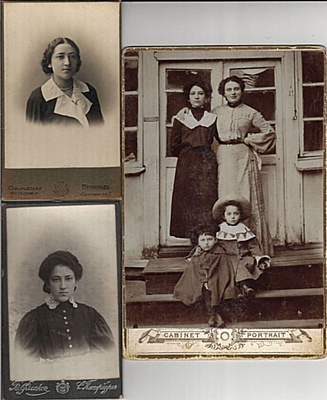
Luba as
a young woman with friends or relatives in

Four photos of Luba as a young woman in
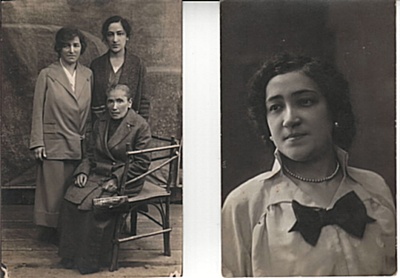
The left hand photo is Pessa, Luba
and Luba's mother, possibly after the first World War - did Pessa go to
post-revolutionary
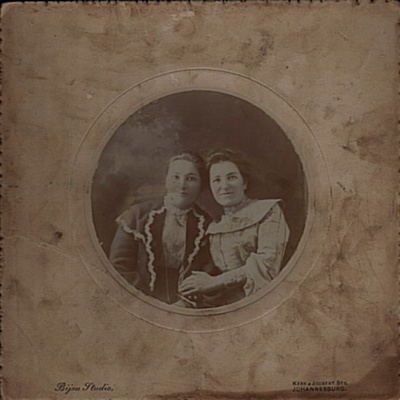
Tziporah and Pessa in
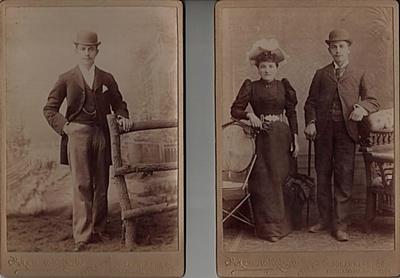
Left-hand photo my grandfather Moshe (Morris), right-hand photo Pessa and Moshe around the time of their engagement - mid-1890s?
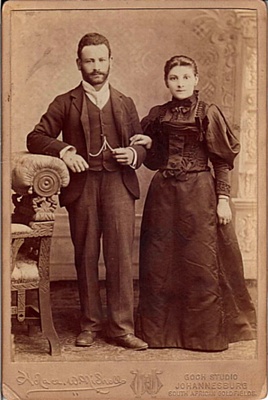
Mr Dorman, first name unknown with Tziporah, his wife and my grandmother's older half-sister, 1890s or early 1900s?
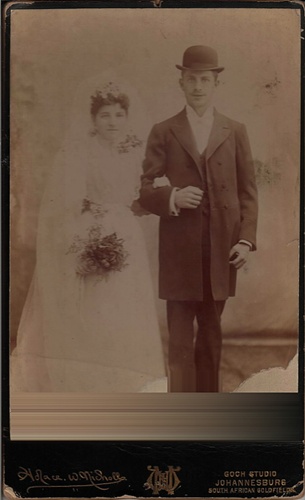
Pessa
and Moshe on their wedding day in
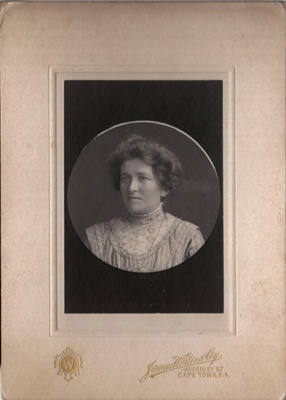

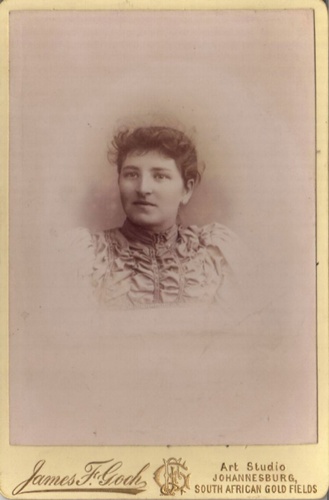
Pessa top photo, Moshe middle photo, Pessa bottom photo - all three in mid to late 1890s?

Tziporah on the left, unknown in the middle, Pessa on the right, mid to late 1890s?
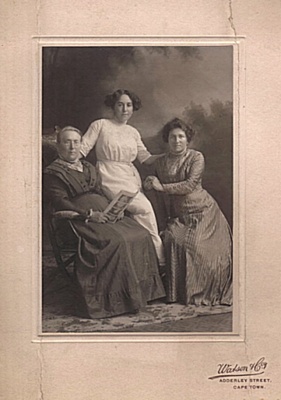
Frume Miriam - wife of Abraham Cooper? left, Jo Freed (Cooper) - her daughter, centre, Pessa Kuper, right, circa late 1890s?

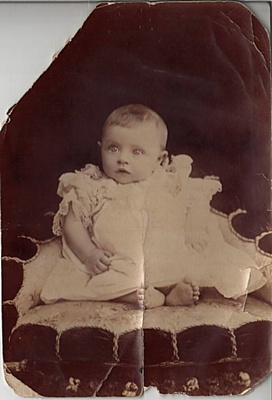
Both above photos are my mother, Annie Rachel Kuper - 1898-1899 as a baby.
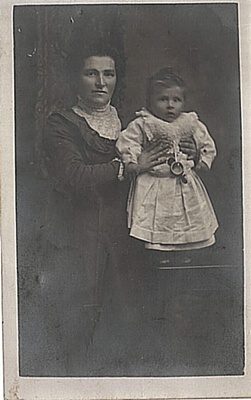
Pessa holding Annie - probably 1899 about the time
they left the
Also in 1899, Pessa gave birth to a stillborn
child. Derek Walker sent the following information from Braamfontein
cemetery: Kuper - Stillborn - aged 0, born
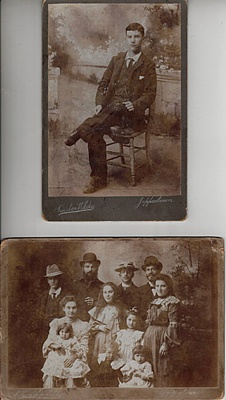
The top photo may be Cozilla (Israel) Cooper, solicitor, as a young man, and the lower photo has on the right, back row Israel Kuper and his brother Moshe - my grandfather, and below them Pessa and Annie and Mary. The others in the photo on the left and middle are unknown to me and I hope someone recognises them to let me fill in the gaps in my knowledge.
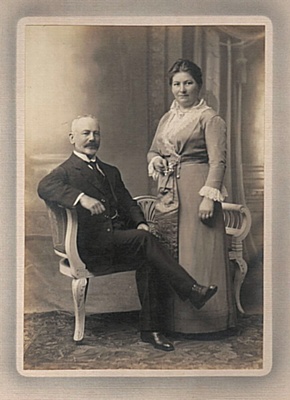
My grandmother Pessa's older
half-sister Tzipora and her husband, (first name
unknown) Dorman, photo taken in
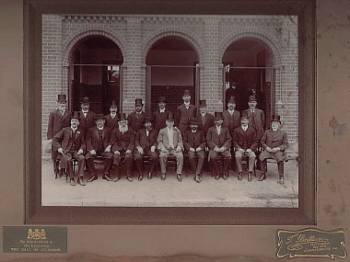
Chaim Kuper (?) third from left in front row? possibly between 1902 and 1910
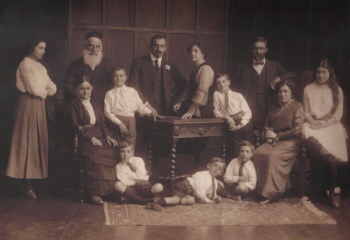
My greatgrandparents Chaim and Sheina Musa Kuper, their two sons, Moshe and Israel, wives Pessa and Tzila, three of Israel and Tzila's sons, Leo, Mike and Sessel (Alex and Charles were not yet born) and Moshe and Pessa's four children, Annie (standing, on the left), Mary (sitting, on the right), Simy and Leo, possibly between 1914 and 1918
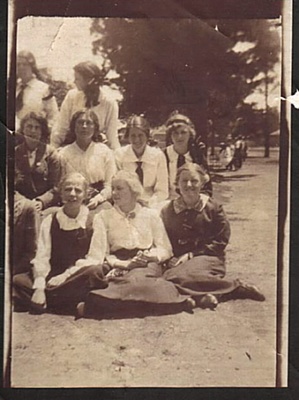
This photo was in my mother Annie's posessions - I don't know who they are and don't recognise any of them - possibly Annie is on the left in the middle row?
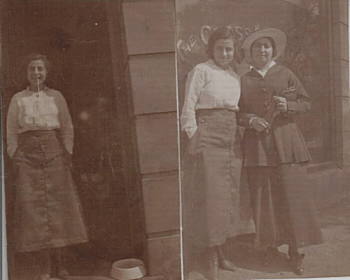
Annie in the left-hand photo and Annie and Jo Freed (Cooper) in the right-hand photo between 1916 and 1918
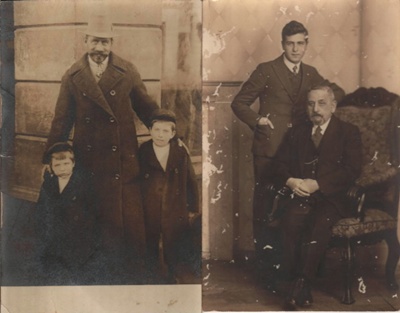
The left-hand photo shows my grandfather Moshe (Pappa
to us), with Leo and Simy possibly around 1912, and
the right-hand photo shows Leo with someone unknown, and, according to the name
of the studio on the back of the photo, taken in
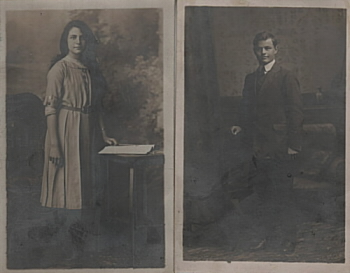
My mother Annie Kuper possibly around 1918 with an unidentified relative in the right-hand photo.
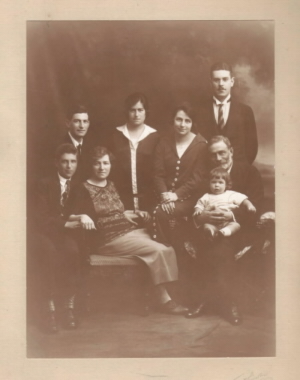
My own immediate family
Back row: Simy, Mary, Annie, Morris
Front row: Leo, Mama, Papa holding Molly on his lap - about 1924 or 1925

IN MEMORY OF MY COUSIN CHARLES GOETHE KUPER
Born in
Died in
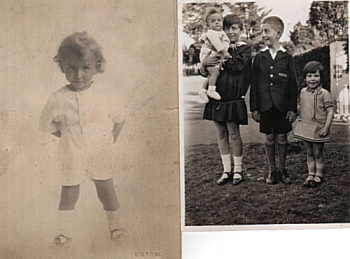
Left-hand photo possibly Charles aged 2 or 3, and right-hand photo, possibly taken by my father Morris De Saxe, of Molly with Alex and Charles Kuper and one of their Gordon cousins, around 1927.
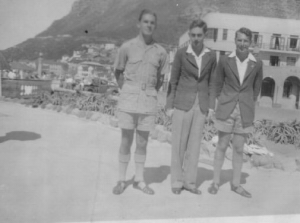
I believe this photo was taken in Muizenberg in about December 1945. A friend, Alwyn Zoutenberg is on the left, Charles Kuper in the middle, and me, Mannie De Saxe on the right. We would have been 19 years old at the time.
When we were still at primary school, something was triggered off that led to Charles actually picking a fight with me when I arrived at school one morning.
Charles and I were bullied, for the same and different reasons. Charles excelled at school, but we neither of us played sport so we were picked on and bullied. Charles wanted to show that he could win a fight and picked one with me. I retired with a bloody nose and he won the fight. It took us some time to get over what had happened, but eventually we became good friends again.
Another strange episode occurred when we were both at Hebrew school at the same time and in the same class. We were post-barmitvah and in our early teens. I don't remember what caused the actual incident but the Hebrew teacher had been annoyed by a pupil in the class and took his cane to cane the boy. In an unusual stance, Charles went to the front of the class, snatched the cane and broke it in half.! The Hebrew teacher was as astonished as were the rest of us, and I don't think he tried to cane anyone again after that, although I think he did get another cane!
However, his early years had some interesting and contrasting anomalies. Charles was certainly modelling himself in some ways on his older brother Alex, who was still at home during Charles' childhood years. Alex was a practical joker, and Charles caught on very quickly. He also had a very wierd sense of humour.
Many of the practical jokes he enjoyed perpetrating had been learnt from Alex, and one of the favourites was plastic dog poo, which looked like the real thing. One day Charles arrived at our house, everybody was out except my very elderly and frail grandmother, who lived with us for the last five years of her life. She was actually Charles' aunt, but the fact that she was frail didn't seem to enter Charles' understanding. He placed the artificial dog poo on the front door mat, and when he rang the bell and my grandmother found it there she was horrified and of course Charles burst out laughing!
When we got to high school, Charles' father, my great-uncle Israel thought that Charles' intellectual capacity was of genius level, and when Charles achieved outstanding results at the end of our second year in high school, his father was successful in getting the school to promote him, not to the next level but to the one after, so that Charles matriculated a year ahead of the rest of his contemporaries.
In his late teens Charles became an atheist and educated me accordingly.
Charles always believed in me and supported and helped me intellectually. Because I was surrounded by so many intellectuals at school and university I always felt intimidated, and Charles used to assure me that my abilities were no less than those around me.
Charles left to study Physics at
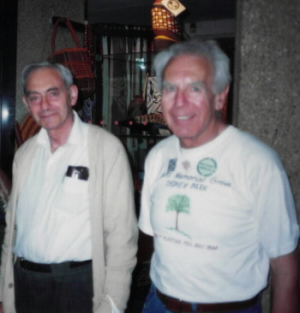
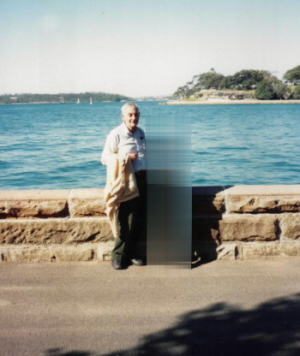
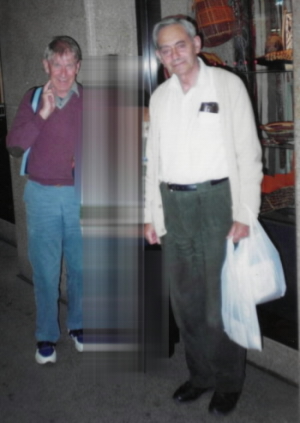

The top and lowest two photos were taken outside a stamp shop in
We didn't see Charles again, but had regular contact by phone and email.
Charles had a long and distinguished career as a physicist at the Haifa Technion, and, despite being long retired, he retained his
study at the Technion, having weekly trips from
Charles was one of my oldest friends and was one of those people with whom I remained friends for my whole life. He will be sadly missed. My partner Ken and I send our condolences to Charles' family. We will plant a tree in his memory at our next tree planting in our SPAIDS Memorial Groves in July 2009, when we have our next day of planting.

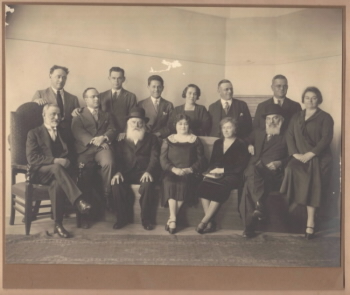
I have tried to work out who is connected to whom in this photo and have established almost all - and their respective siblings in the photo, but I am open to correction! possibly about 1930?
Back row: Moses Cooper (doctor in Vryheid?) brother of Aarie next to him and Esther (Silove) on the extreme right (and Fanny (Noach) third from right in front row), then Jerry Cooper (none of his siblings in the photo), Jo (Freed), sister of Cozilla (Israel) Cooper on the right, and then, Israel Cooper (pharmacist in Lichtenberg?) just before Esther (Silove) (and Jo and Cozilla are siblings of Moses Cooper in the front row, second from the left
Front row: My grandfather Moshe Kuper, husband and first cousin of Pessa (Kuper) who is second from the right, then Moses Cooper (optometrist? and brother of Jo Freed and Cozilla Cooper), then a brother of my greatgrandfather, but I don't know which one, Fanny Noach (sister of Esther), then my grandmother, Pessa Kuper, then my great-grandfather Chaim Kuper, father of my grandfather Moshe and uncle and father-in-law of my grandmother Pessa.
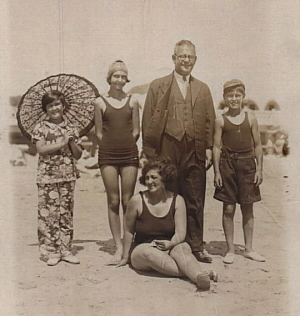
This family group was taken in Muizenberg in 1930 - Cozilla (Israel Cooper), his wife Minnie and three children, Cherry, Abe and Peggy
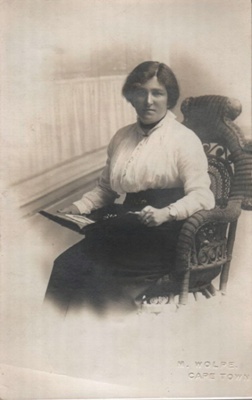
Pessa Kuper - probably taken around mid-1920s
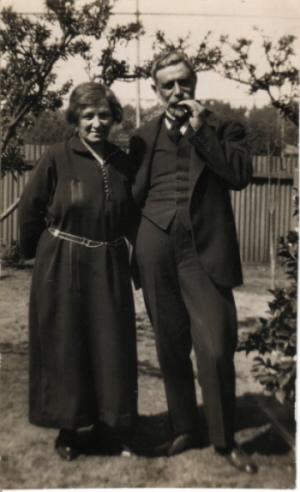
My grandparents Moshe and Pessa Kuper in the garden of their house at 51 Soper Road, Berea, Johannesburg, possibly taken by my father Morris De Saxe around 1925. Moshe Kuper is the elder son of Chaim Kuper.
Derek Walker has provided the following information: Braamfontein
cemetery - site 2394, Kuper, Morris, aged 56, born
1875, died
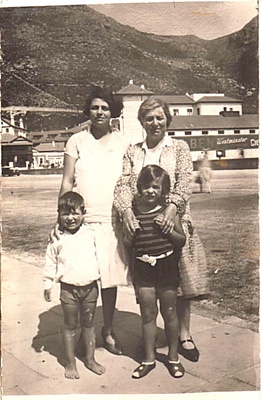
Muizenberg 1930 - a few months after my father Morris De Saxe had died. We were taken on holiday by my grandmother Pessa to help us all recover from illnesses and Morris De Saxe's death
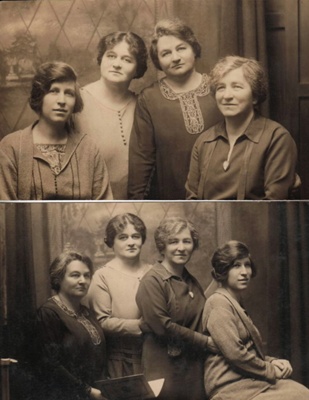
These two photos show Minnie Morris (Rudaitzky), Fanny Noach (Kuper), Esther Silove (Kuper) and Pessa Kuper (Kuper), possibly around the early 1930s.
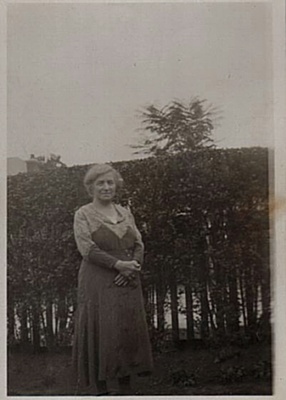
Pessa in the garden at
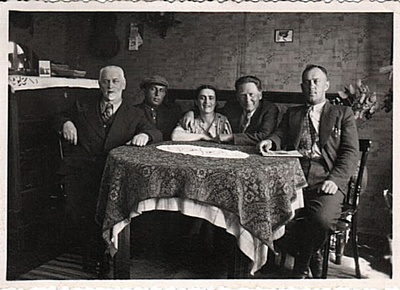
I do not know any of these people and maybe someone will let me know who
they are - was this taken in
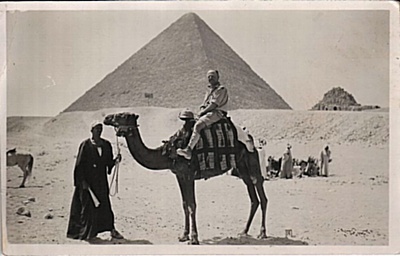
Moses (Big eyes) Cooper in
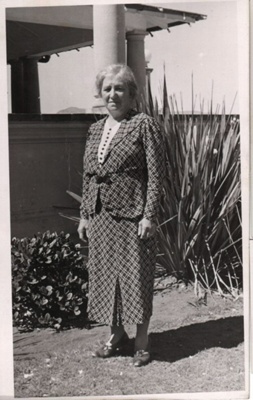
Pessa on holiday in Muizenberg during the early 1940s
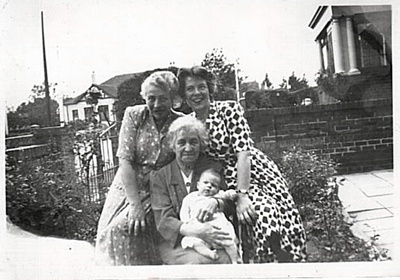
This photo was taken at
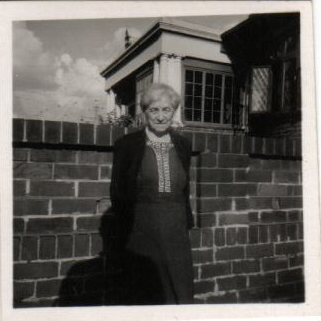
Pessa
at
The South African Jewish Times published the following obituary of my
grandmother Pessa Kuper on
THE LATE MRS. PESSA KUPER
A Pioneer of Johannesburg
Representatives of all leading Jewish communal organisations in Johannesburg were present at the Braamfontein Cemetery on Thursday of last week, when the late Mrs. Pessa Gitte Kuper, mother of Mr. S.M.Kuper, Q.C., Chairman of the S.A.Zionist Federation, was laid to her final rest beside her husband, the late Mr. Moshe Kuper, one of the founders of the Beth Hamedrash Hagodel and one of the pioneer builders of orthodox Jewry in Johannesburg.
The late Mrs. Kuper, who died at the ripe old age
of 80 (sic), came to this country from Shavel in
1893, to join her father, who had settled in
From the arrival of the first Kuper on the Rand,
the family worked tirelessly in the cause ofOrthodox
Jewry, and from then right up to the present day, members of the family have
been among the builders and leaders of Jewish religious life in
The late Mrs. Pessa Kuper was an "Eshet Chayil" in the true sense of the word, devoutly orthodox, a woman who always kept open house and devoted herself to charity and good deeds.
She had four children, Mr. S.M.("Simie") Kuper, Q.C.,
Chairman of the S.A.Zionist Federation; Prof.Leo Kuper, of the
The funeral was conducted by Cantor A. Reich, and Rabbi Dr. M Kossowsky delivered the Hesped.

The following item appeared in the Zionist Record on
A TRIBUTE TO MRS. PESSA KUPER
It is hard for anyone who really knew her to believe that Pessa Kuper is dead. A white-haired little bundle of old age, humour and gentleness, she was the unacclaimed head of the Kuper-Cooper clan, with its ramifications through the 11 offspring of grandfather Kuper and their subsequent cousins and offspring, to the third remove.
Members of this large family who never knew
one another all came to see Pessa, no matter how
fleeting their visit. She was the pivot of the family, and she embraced them
all in her affections, listened to their troubles, made excuses for Kuper shortcomings, which, when we chided her for her
family loyalties, she excused by saying: "Well, you see I'm a double Kuper - I was a born Kuper and I
married a Kuper, so I can't help it." No one
left her without a warm glow of affection, a sense of protectiveness, and,
above all, a sense of humility at her wisdom and tact.
EARLY DAYS
I, for one, could sit for hours and listen to her reminiscences of the early days of arrival in Johannesburg to live with her uncle and aunt, with whose son, Meisha, she had "an understanding"; of the reaction of her Orthodox, old-fashioned aunt to her revolutionary decision to go to school at the age of 20 or so, alongside youngsters of ten, in order to learn English; of her first job as a saleswoman at Store Brothers and her battle to rescue her books from the kitchen stove, because her aunt, and later her mother-in-law, had decided that she had had enough of education, and, anyhow, women didn't need to read books.
Ferriera's town, house by business, and business
by back-room, came alive as she talked of the people, of the shops, the
"characters" who dropped in for a card game
or a discussion. She related with little, sly, humorous comments the arguments
everybody heard from the neighbours' cheek-by-jowl houses; and of the whole
buzz of the Orthodox Jews there amid the red dust and beginnings of
OPEN HOUSE
After Ferriera's town came
a house in
No member of the Kuper family visiting
And even now at 78 she loved people. She resented her confinement due to ill-health and her greatest daring was to escape on a forbidden visit to town when left alone. But the last few months were mostly spent in bed, where she lay, a frail wisp amidst her pillows and her books and in answer to your question of how she was, she smiled and said: "As long as I'm here and I can laugh, it's still good. But tell me how are you?"
A visit to "Auntie Pessa" was something we did for amusement. It was no family "have to." She was the unofficial head, not by domination or interference, but through affection and humility.
MOLLY COOPER.(Molly
was married to Leslie Cooper, whose father
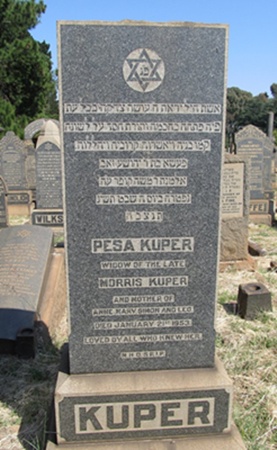
Photo by Derek Walker, sent May 2012 - from Braamfontein cemetery
The next photos arrived from Derek a few days after the first one, with an approximate Hebrew translation:
Pesa Kuper
A Woman of valor (capable woman)
She feared God
Gave to charity all the time (at any time)
Wisdom came from her mouth
With the doctrine of kindness/benevolence/goodness on her tongue
Her sons and her relatives rose to confirm and praise/glorify/exalt her
Pesa, daughter of Mr. Yehoshua
Ze'ev (Joshua Wolf)
The widow of Mr Moshe (Morris) Kuper - May he rest in
peace
Died on the 5th day of Shvat, tashyag
(the Jewish year in letters)
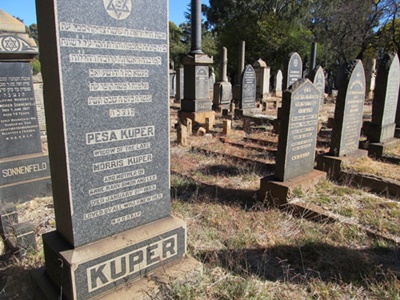 -
-

1997 photo
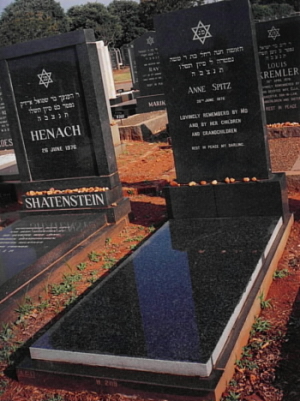

MY AUNT MARY
HER STORY
Mary Kuper
born
died
circa 1905
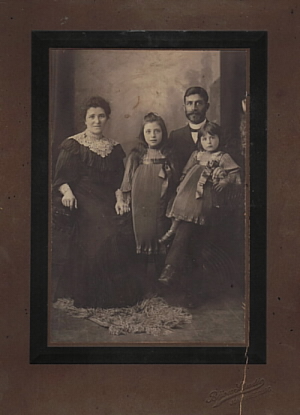
This photo was taken by Bijou Studios in
circa1908
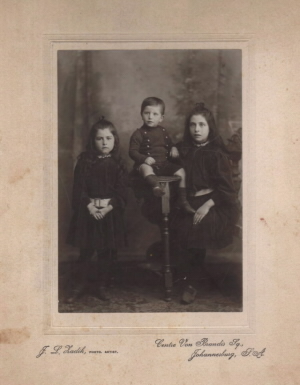
circa1908
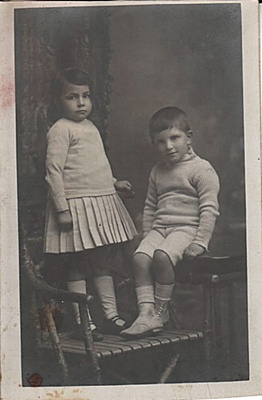
circa 1914
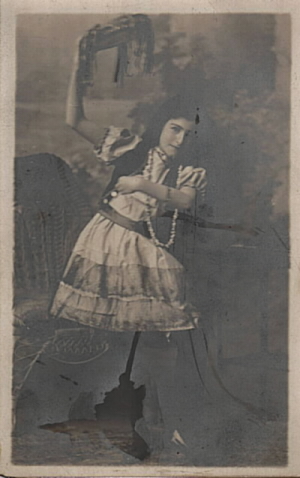
circa 1918
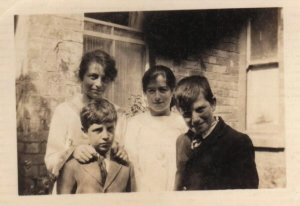
circa 1918
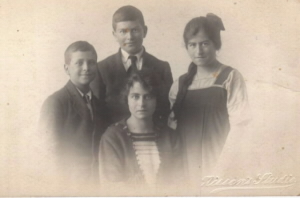
circa 1920

circa 1923
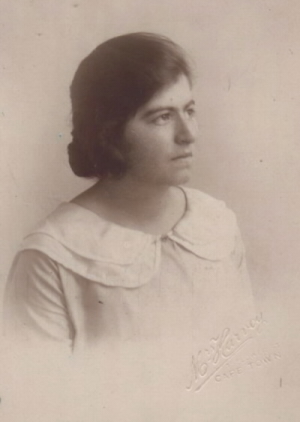
circa 1926
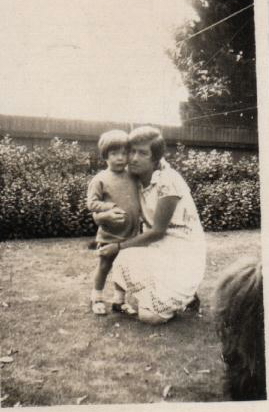
This photo of Mary with my sister Molly was probably taken around 1926.
circa 1929
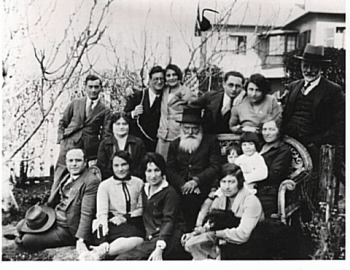
Back row from left - Harry Glaser (husband of Zlate Litvin?), my uncle Simy Kuper holding Sophie Prisman, Mannie Bloch, solcitor, leaning on my mother Annie, my grandfather Moshe Kuper.
Middle row from left - Fanny Noach (Cooper), my great-grandfather Chaim Kuper, me (Mannie De Saxe), my sister Molly, my grandmother Pessa.
Bottom row from left - Moses (little Moses) Cooper, Janie Berman (Prisman), Dolly Cooper (Eisenhammer), my aunt Mary with our dog Bossie.
circa 1930
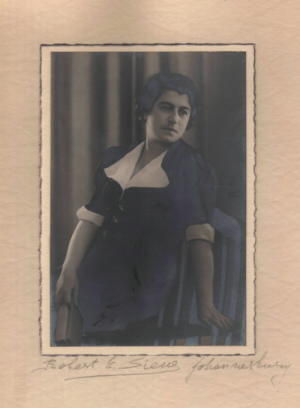
My uncle wrote a long letter to me in 1990, with a great deal of family history about which I was not aware. I think he needed to get things off his chest after having carried the traumas around with him for much of his life.
This is an extract from the letter: "We had always though that Mary and Mo would marry. But things changed after Maurices(sic) death and I remember one terrible scene when my mother and I were in the backyard with Mary and Anne, and Mary reproached Anne for taking Mo from her." (Mo was to become my stepfather in 1931)

1936

In 1936 Mary went on holiday to
1936
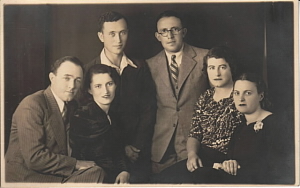
The three people on the right-hand side of the photo are Joseph Levitan, my aunt Mary, and Joseph's wife Chaia. I do not know who the three on the left-hand side are.
The holiday was somewhere between 3 and 6 months, and when they returned,
Mary was married to Ziggy Bornstein who lived in
Mary used both spellings of the name Kuper/Cooper,
by which many members of our family in
It is possible that she used Cooper for professional purposes in the legal fraternity, although, in the article below, on the Johannesburg Legal Aid Bureau, she was using the Kuper spelling.
Her law degree was awarded to her under the name Mary Cooper from the
University of the
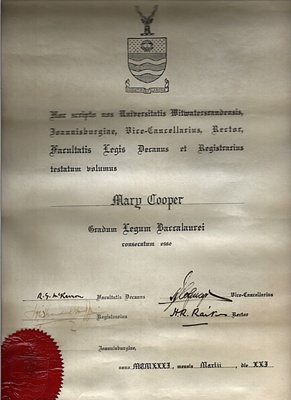

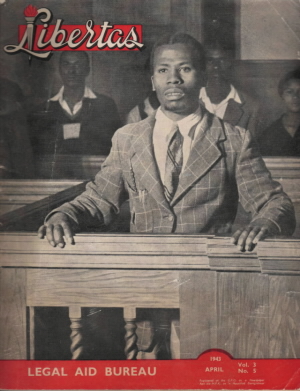


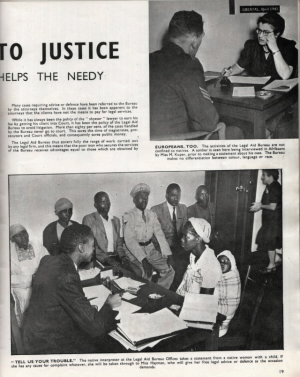
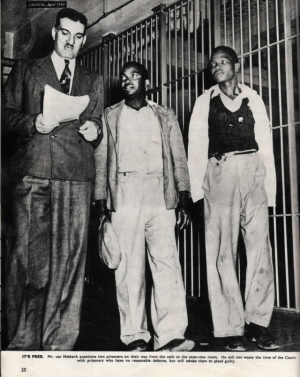
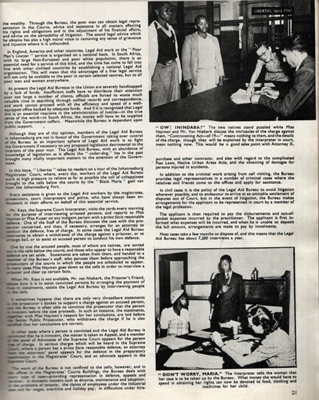

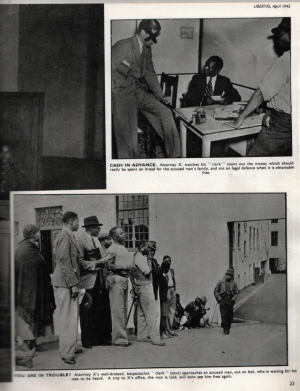

circa 1939
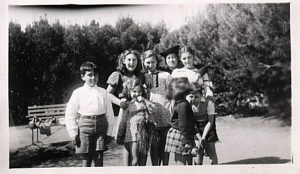
circa 1939

1940
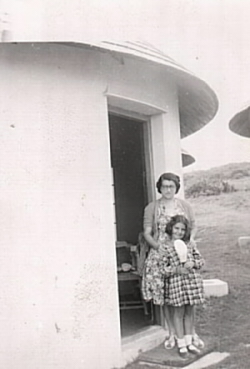
1946
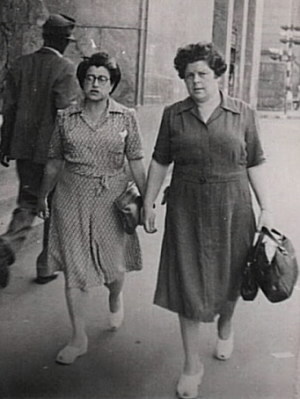
circa 1947
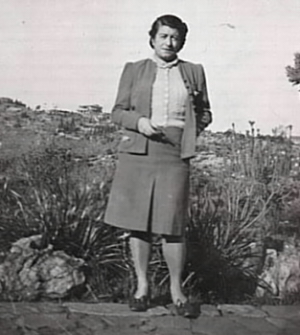
I took this photo at the Wilds in
SEPTEMBER
1948

This is probably the last photo of Mary, taken on the beach in
This is another extract from my uncle's letter to me about the family: "And then Marys absurd, tragic, arranged marriage, and later Hilda and I were in North Carolina, living in a lovely wooden oneroomed house Jenny had arrived the setting was idyllic, a garden of Eden, with snakes too in the fountain where we used to put Jennys pram. And one night I could not sleep. I felt something unnatural was happening. And a day or two later there was a cable from Simie Mary was dying of leukaemia, there was no point in our returning we would be too late. But we came back anyhow. Mary was still alive. I had a research report to do, and I set up my table outside Marys room. And then one day she went into what seemed a final death rattle, and I stayed by her, stroking her arm. But she pulled through that. But then a little later, she went into a final death rattle. I stayed by her, stroking her arm then the nurse said speak to her and I did and I could see that my words penetrated the darkness. And then suddenly there was an illumination. Her eyes opened she was radiant. She said Leo Anne came rushing in she tried to say Anne, and that was the end."

Mary died on
THE LATE MISS MARY KUPER
The community has suffered a very grave loss in the death of Miss Mary Kuper, who passed away in
Miss Kuper was in charge of the Legal Aid Bureau and devoted herself completely to her work, displaying, even at the most exacting times, her overwhelming tolerance and great gift of sympathy. She became a true friend of the endless stream of people who, year after year, came to her seeking a way out of their difficulties.
Her task was not an easy one, but she never wavered in her resolve to assist those who were the victims of either misfortune or folly. She knew not the meaning of self-gain, nor the rashness of ill-humour. Life's reward for her lay in the alleviation of the distress of others.
Despite her constant contact with human suffering she never became hardened, or ever failed to treat each and every case she encountered on its true and individual merits.
She was born in
Mary Kuper took her L.L.B. at the
J.B.

CHAPTER 1: MENDELSSOHN FAMILY PART 1
CHAPTER 2: MENDELSSOHN FAMILY PART 2
CHAPTER 6: THE STORY OF MORRIS (DE SAXE)

Contact me at: red-jos_at_red-jos_net

Mannie and Kendall Present: LESBIAN AND GAY SOLIDARITY ACTIVISMS
Mannie's weblogs may be accessed directly by clicking on to the following links
Activist Kicks Backs - Blognow archive re-housed - 2005-2009

Genealogy only Copyright ©: De Saxe Family
This page updated 6 SEPTEMBER 2013 and again on 20 JUNE 2020
PAGE 32